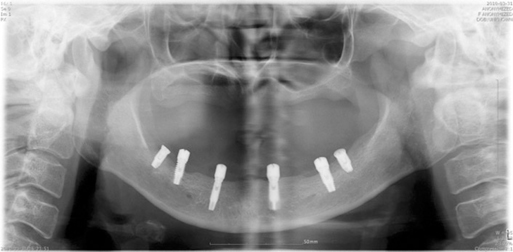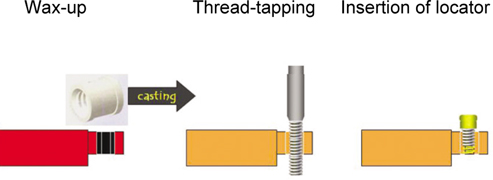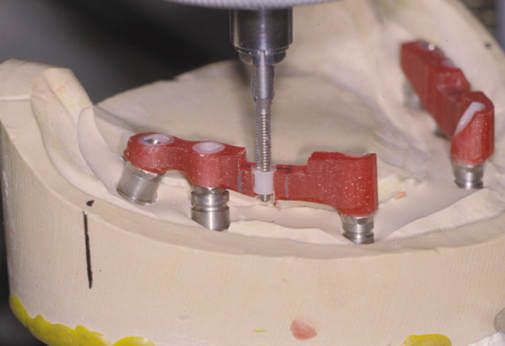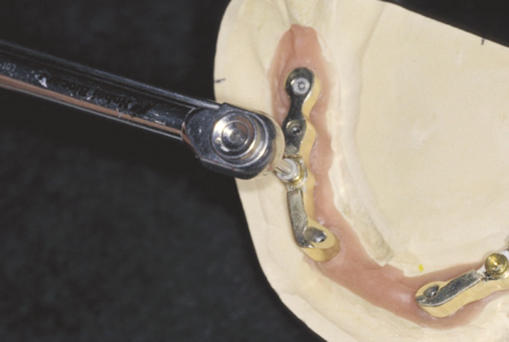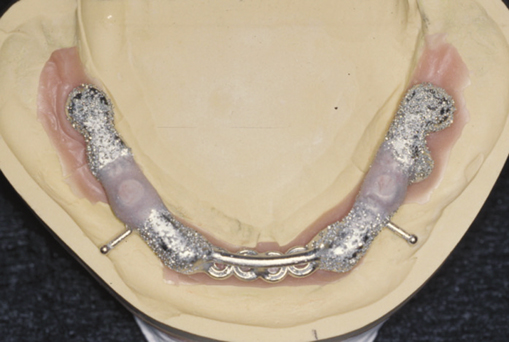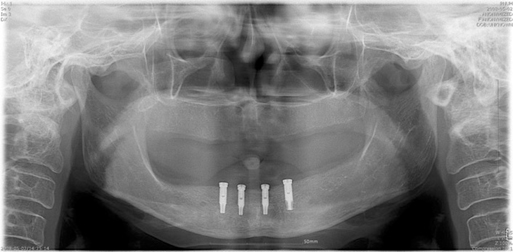J Adv Prosthodont.
2012 May;4(2):116-120.
Implant overdenture using a locator bar system by drill and tapping technique in a mandible edentulous patient: a case report
- Affiliations
-
- 1Department of Prosthodontics, School of Dentistry, Pusan National University, Yangsan, Korea. cmjeong@pusan.ac.kr
Abstract
- Various options have been introduced for the selection of implant overdenture attachments. Attachment wear due to the repeated insertion and removal of dentures has caused problems such as decreased retention and the requirement for suprastructure remanufacturing. In these cases, a Locator bar system was applied using the drill and tapping technique to achieve total retrievability. In a 55-year-old female patient who showed three degrees of mobility in most of her teeth due to severe alveolar bone loss, a complete denture in the maxilla and an implant supported type overdenture in the mandible were planned after extracting all the remaining teeth. Six implants were placed from canine region to the distal molar region, and the locator was connected to the milled bar using the drill and tapping technique. For a 61-year-old female edentulous patient who complained of poor retention with old denture, a complete denture in the maxilla and an implant-tissue supported type overdenture in the mandible were planned. Four implants were placed in front of mental foramen, and the Locator was also connected to the Hader bar using the drill and tapping technique. With this technique, female parts can be easily replaced, and retention can be continuously maintained.
MeSH Terms
Figure
Reference
-
1. DeBoer J. Edentulous implants: overdenture versus fixed. J Prosthet Dent. 1993. 69:386–390.2. Sadowsky SJ. The implant-supported prosthesis for the edentulous arch: design considerations. J Prosthet Dent. 1997. 78:28–33.3. Adell R, Lekholm U, Rockler B, Brånemark PI. A 15-year study of osseointegrated implants in the treatment of the edentulous jaw. Int J Oral Surg. 1981. 10:387–416.4. Trakas T, Michalakis K, Kang K, Hirayama H. Attachment systems for implant retained overdentures: a literature review. Implant Dent. 2006. 15:24–34.5. Kurtzman GM. Lab techniques for use of the locator attachment in bar-overdenture applications. TeamWork. 2008. 1:72–78.6. Schneider AL, Kurtzman GM. Bar overdentures utilizing the Locator attachment. Gen Dent. 2001. 49:210–214.7. Naert I, De Clercq M, Theuniers G, Schepers E. Overdentures supported by osseointegrated fixtures for the edentulous mandible: a 2.5-year report. Int J Oral Maxillofac Implants. 1988. 3:191–196.8. Celik G, Uludag B. Photoelastic stress analysis of various retention mechanisms on 3-implant-retained mandibular overdentures. J Prosthet Dent. 2007. 97:229–235.9. Pasciuta M, Grossmann Y, Finger IM. A prosthetic solution to restoring the edentulous mandible with limited interarch space using an implant-tissue-supported overdenture: a clinical report. J Prosthet Dent. 2005. 93:116–120.10. Lee CK, Agar JR. Surgical and prosthetic planning for a two-implant-retained mandibular overdenture: a clinical report. J Prosthet Dent. 2006. 95:102–105.11. Chung KH, Chung CY, Cagna DR, Cronin RJ Jr. Retention characteristics of attachment systems for implant overdentures. J Prosthodont. 2004. 13:221–226.
- Full Text Links
- Actions
-
Cited
- CITED
-
- Close
- Share
- Similar articles
-
- The Implant Retained Overdenture by Locator Attachments on the Edentulous Mandible: A Case Report
- Clinical evaluation of mandibular implant overdentures via Locator implant attachment and Locator bar attachment
- Implant-retained overdentures with pre-fabricated bar attachment system in edentulous patients
- Implant-supported overdenture with prefabricated bar attachment system in mandibular edentulous patient
- Causes of failed implant attachments and application of double crown implant overdenture in one patient

